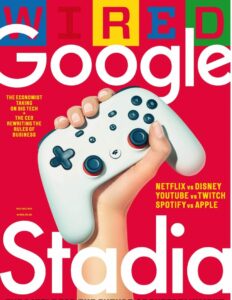It’s Game on for 5G! – Notes from the Microcast
Welcome to the second installment of our ‘bite-sized thought leadership’
This time we tackled a market opportunity that has been garnering quite a bit of media and analyst attention: the impact and potential of cloud gaming on 5G mobile networks. It includes contributions from Gorkem Yigit of Analysys Mason, and Stephen Armstrong, one of the UK’s leading investigative journalists who recently provided WIRED magazine with an in-depth cover feature on Google Stadia.
This article builds on the themes of the Microcast and summarises some of the issues raised.
What is the dream for cloud gaming on mobile?

What’s more even people in the audience of this “stadium” could enter the fray. Consider for example Google’s ownership of YouTube as well as Stadia. Any viewer watching a game on YouTube could, at the press of a button, enter the game – no limit to numbers.
However, the principal use case according to Armstrong, is the fact that the game is no longer tied to a specific device and its location. A user could start playing say Assassin’s Creed, at home, on their big screen and then “flip it” to playing on their mobile because they have to go out – picking up the game at the exact same point and continuing their mission on a bus, taxi or train. Finally, arriving at their destination, they could flip the game back on to a big screen, and so forth.

What’s needed to make this happen and who are likely to be the big players?
There’s no doubt this vision requires 5G. With 5G there is theoretically no limit to the devices that could accept the game and deliver playability. With 4G, mobile gaming that relies on cloud-based interaction with complex worlds and immediate response to commands is a non-starter – Google Stadia and other cloud gaming platforms cannot work in a 4G world.
Currently the games world is dominated by the three console providers: Nintendo, Sony with PlayStation, and Microsoft with X-Box, all of which are hardware-led approaches. Cloud gaming requires a service provider with access to a huge number of server farms all around the world. Nintendo and Sony are not on that same level – so they need partners.
That means the only viable providers in the marketplace at the moment are Google Stadia, the newcomer, and Microsoft, the old hand – the two could almost take on a “cable provider” role providing their servers and the content you can access from any device with any remote, and potentially offering their infrastructure out to others. Indeed recently Sony partnered with Microsoft and they are working together. There is a possibility that Microsoft’s cloud becomes the de facto alternative to Stadia and seeks to win the market share battle through partnerships with the likes of Nintendo.
What about the content providers – what’s their role?
Games live or die in a very short space of time and the reality is that the games industry is getting closer and closer to a Hollywood style business model with its big studios and independent art houses. In that sense the games industry has similarities with the broadcasting market where companies vie to engage with subscribers and vie for their attention through their content acquisition – be it through sports, drama or movies. That’s one of the reasons why content streaming companies like Netflix are concerned about cloud gaming and the games market in particular. In fact, in a recent set of results, Ted Sarandos (Chief Content Officer, Netflix) said “we lose more hours of viewing time to Minecraft than to HBO”.
Historically, the console companies have made their reputation – or driven sales of a new piece of hardware – with one or two blockbuster games. In particular, they have looked to have centrepiece games that are locked so you can only play them on their console. They can commission games themselves and spend anything up to $500m in the process. However, there are also some very big game publishers – such as Activision Blizzard Entertainment, Electronic Arts and Ubisoft – with the power to insist their titles are available across all platforms.
Alongside that, in gaming just as it is in entertainment and video streaming, there are independent gaming developers operating on platforms like Stream or Twitch producing popular games that are cheap to make. They have their limitations, but they have a role to play within the gaming ecosystem.
The technology challenge
Whether it is playing at home or playing on the move, latency remains the challenge.
With content video streaming, latency is relatively easy to deal with: Netflix and the other video streaming companies delay the initial viewing to the extent that you are always watching anything up to ten seconds behind the stream, or in other words there is always 10s or so of buffered video waiting to be viewed, so slight interruptions in packet delay are imperceptible – the viewing experience is usually smooth once it begins.
Within the games world that can’t happen. The user’s reaction to the video on screen effectively changes the video. Clearly a user’s actions in a game clearly cannot be predicted and downloaded ahead of their occurrence. So what is required is an ultra-low latency connection so that those reactions can be transmitted, received and relayed back in “real time”. There are leading edge codecs from Google and others that can help facilitate ultra-low latencies, but for cloud gaming to work well, even in the home, requires a good, high speed broadband connection and a server farm hosting the game relatively nearby and not on the other side of the world. That’s why the big players will be those with a host of server farms.
From a mobile perspective, only a 5G network with guaranteed low-latency connections has any chance of serving the cloud gaming market. And even that will need to be coupled with intelligence and mobile edge servers to deliver the speed in terms of both upload and round-trip time.
What’s the role of the mobile operator?
It’s key. The dream of Stadia and cloud gaming relies on fast speeds and it will rely on mobile operators to make the difference. After all, what’s the point of having a system when you can flip a game from TV to computer to smartphone if they are all in the same room? The use case only becomes attractive if you can take the game out of the TV on to your mobile device – and leave home with it.
While Google may talk a lot about the latency of its broadband and its server farms, that’s only about a quarter of what is needed. Google will need 5G latency effectively of zero. Without that, the model doesn’t really work.

Arguably – as Gorkem Yigit points out – operators could seek to gain market advantage by offering a “Game-ready 5G network”. That will require rapid adoption of techniques such as network slicing to create the guaranteed low-latency pathways, and an investment in the supporting transport infrastructure.
The Radio Access Network (RAN) is the most significant contributor to the latency challenges associated with mobile cloud gaming. 5G network slicing tackles that problem head-on, and in combination with mobile edge computing, it can create the right guaranteed environment. First mover advantage could be significant.
Can operators guarantee QoE and subscriber satisfaction for 5G gaming?
The market numbers suggest that they have no alternative and will have to build networks that can guarantee the service.
A poll conducted by the Mobile Video Council (MOVIC) that involved more than 50 operators including Vodafone, Orange, Deutsche Telekom, Verizon, AT&T and Telefonica – revealed that most believed cloud gaming could represent anywhere between 25% and 50% of their 5G data traffic by 2022.
Operators cannot put that level of revenue at risk. What will especially concern operators is that research among mobile subscribers who had experienced delays when watching video services such as Netflix or simply YouTube on their handsets was that they straightaway blamed the operator rather than the content provider for any shortfall in service.
In summary, there’s little doubt the gaming content will be created, there’s little doubt that there are compelling use cases for cloud gaming on mobile, and there’s little doubt the market demand will exist. The only doubt lies in how quickly it is established and how soon the mobile network operators can spring into action to support it. The battle lines are being drawn.
Register for Microcasts
Our short 15-minute videos bring together thought-leaders and commentators to look at a range of mobile operator challenges and market opportunities. Register on MOVIC (Mobile Video Council) site
In case you missed the first microcast, ABI Research, Tutela and Root Metrics looked at operator benchmarking – you can watch it here
Want to speak on an upcoming Microcast?
We are always looking to add guest interviews, let us know if you think that could be you. Contact us: [email protected].





